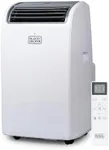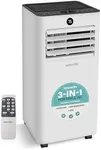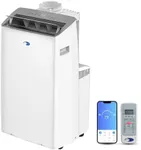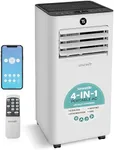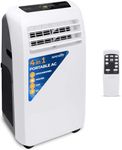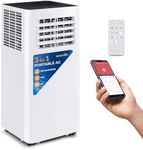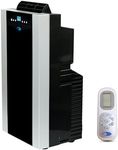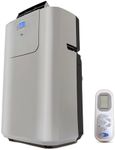Buying Guide for the Best Quiet Portable Ac Units
Choosing a quiet portable air conditioner is all about balancing cooling power, noise level, and convenience. Since these units are designed to be moved from room to room, it's important to consider how easy they are to transport, how well they cool your space, and how quietly they operate. Think about where you'll use the AC most often—bedrooms, offices, or living rooms—and how much space you need to cool. Also, consider how sensitive you are to noise, especially if you plan to use the unit while sleeping or working.Noise Level (dB)Noise level, measured in decibels (dB), tells you how loud the air conditioner will be when it's running. This is especially important if you want a quiet environment for sleeping, working, or relaxing. Lower dB values mean quieter operation. Generally, units under 50 dB are considered very quiet and suitable for bedrooms or offices, while those between 50-60 dB are moderate and may be fine for living rooms. Anything above 60 dB can be noticeable and potentially disruptive. If you are sensitive to noise or plan to use the AC at night, look for models with the lowest dB ratings.
Cooling Capacity (BTU)Cooling capacity, measured in British Thermal Units (BTU), indicates how much heat the unit can remove from a room per hour. This is crucial for ensuring the AC can effectively cool your space. Smaller rooms (up to 200 sq. ft.) typically need 8,000-10,000 BTU, medium rooms (200-400 sq. ft.) need 10,000-12,000 BTU, and larger rooms (400+ sq. ft.) may require 14,000 BTU or more. Choosing the right BTU ensures efficient cooling without overworking the unit, which can also help keep noise levels down.
Portability FeaturesPortability features include the unit's weight, size, and the presence of wheels or handles. These factors determine how easy it is to move the AC from one room to another. Lighter units with sturdy wheels and comfortable handles are easier to relocate, which is important if you plan to use the AC in different areas of your home. If you have limited strength or need to move the unit frequently, prioritize models that are compact and easy to maneuver.
Energy EfficiencyEnergy efficiency tells you how much electricity the unit uses to cool your space. More efficient models use less power, which can save you money on your energy bills and reduce environmental impact. Look for units with an Energy Efficiency Ratio (EER) or those labeled as energy-saving. Higher EER values mean better efficiency. If you plan to run the AC for long periods, choosing an efficient model can make a noticeable difference in your energy consumption.
Dehumidification FunctionMany portable AC units also act as dehumidifiers, removing excess moisture from the air. This is especially useful in humid climates or for people who are sensitive to dampness. The dehumidification capacity is usually measured in pints per day. If you live in a humid area or want to improve comfort by reducing moisture, look for a unit with a strong dehumidification function.
Control OptionsControl options refer to how you operate the AC, such as through a remote control, digital display, or smart features like app connectivity. Easy-to-use controls make it more convenient to adjust settings, especially if you want to change the temperature or fan speed from across the room. If you value convenience or want to integrate the AC with smart home systems, look for models with advanced control options.
Exhaust and VentingPortable AC units need to vent hot air outside, usually through a window kit. The design and flexibility of the exhaust system can affect how easy it is to set up and move the unit. Some units have more adaptable or longer hoses, making them easier to fit in different window types. If you have unusual windows or plan to move the unit often, check that the venting system will work for your space.
